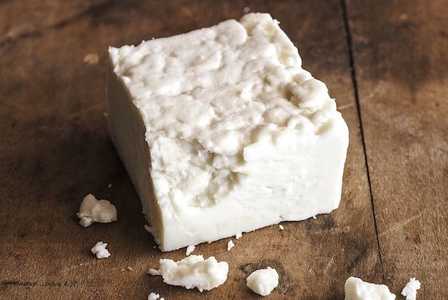- 1 gallon pasteurized whole goat milk
- 1/8 teaspoon mild lipase powder, dissolved in
- 1/4 cup cool nonchlorinated water
- 20 minutes before using
- 1/4 teaspoon direct-set mesophilic starter (preferably MM100 or MA011)
- 1/4 teaspoon liquid calcium chloride, diluted in
- 1/4 cup cool, nonchlorinated water
- 1/2 teaspoon liquid rennet, diluted in
- 1/4 cup cool, nonchlorinated water
- 2 to 4 tablespoons kosher or flake sea salt
- 10 ounces kosher salt (preferably Diamond Crystal) dissolved in
- 1/2 gallon cool, nonchlorinated water and chilled to
- 55° F (optional, for brine)
- In a nonreactive stockpot, combine the milk
and the diluted lipase. Gently heat over low heat to 86° F. This should take 25 to 30 minutes. Remove from the heat.
- Sprinkle the starter over the milk and let it rehydrate for 2 minutes. Whisk the starter into the milk, using an up-and-down motion to distribute thoroughly. Cover, maintaining a temperature of 86° F, and allow the milk to ripen for 1 hour.
- Add the diluted calcium chloride: whisk it in gently, using an up-and-down motion, for a few minutes, then add the rennet in the same way.
- Cover and allow to sit at 86° F for 1 hour. The curds will be a sold mass at this point and the light yellow whey will float to the top. The curds should show a clean break when test-cut with a knife; if there is no clean break at this point, let the curds set for another 10 minutes, then test again.
- Cut the curds into 1/2-inch cubes. Maintaining a temperature of 86° F, allow to sit undisturbed for 10 minutes.
- Using a flexible rubber spatula, gently stir the curds for 20 minutes, raising the temperature to 90° F. This action will release more whey and keep the curds from matting together. The curds will look more pillow-like in shape at the end of this process.
- Let the curds rest for 5 minutes, undisturbed. They will settle to the bottom of the pot.
- Line a strainer with dampened cheesecloth or butter muslin, leaving excess cloth hanging over the sides of the strainer. Using a slotted spoon, spoon the curds into the prepared strainer.
- Tie the corners of the cloth together to create a draining sack, slip a wooden spoon handle through the knot, and hang over a deep cooking pot or bucket to drain for 10 minutes.
- Transfer the curds from the cheesecloth to a square feta cheese mold, press them into the corners, generously salt the surface, and allow to finish draining. After 1 hour, flip the cheese over, return to the mold, and generously salt the surface again. This will help even out the texture and firm the cheese. Cover the molds with cheesecloth and allow to drain at room temperature for 8 hours or overnight.
- Cut the cheese into slices that are 1 1/4 inches thick, and then cut again into cubes. Sprinkle the chunks with salt, making sure all the surfaces are covered. Loosely cover the bowl with a lid or plastic wrap and allow to age in the salt for 5 days in the refrigerator. The cheese can be covered with brine at this point for 21 to 30 days to further cure and add saltiness. If the finished cheese is too salty for your taste, set the cheese in nonchlorinated water for 1 hour then drain before using.
- **Specialized cheese making ingredients and supplies can be purchased online from The Beverage People, www.thebeveragepeople.com. Other resources can be found on www.artisancheesemakingathome.com
